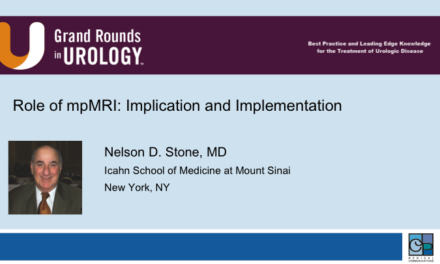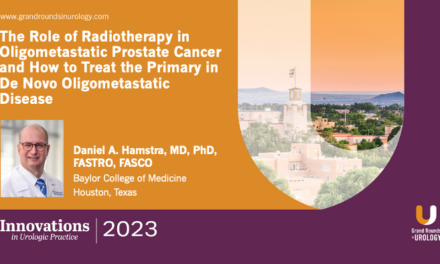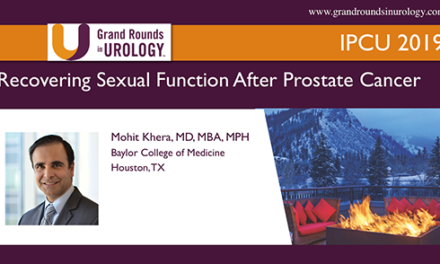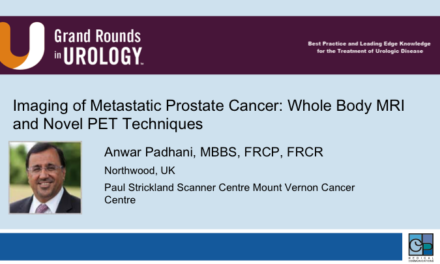Dr. Leonard Gomella spoke at the 24th International Prostate Cancer Update on Saturday, February 22, 2014 on “Multidisciplinary Treatment for Urologic Cancers at Thomas Jefferson University.” In his presentation, Dr. Gomella discusses the treatment methods for urologic cancers being used at Thomas Jefferson University.
Presentation:
Keywords: prostate cancer, urology, multidisciplinary approach, oncology, radiation, prostatectomy, biochemical
How to cite: Gomella, Leonard G. “Multidisciplinary Treatment for Urologic Cancers at Thomas Jefferson University.” Grand Rounds in Urology. January 22, 2015. Accessed Apr 2024. https://grandroundsinurology.com/mens-health-leonard-gomella-multidiciplinary-treatment/.
Transcript
Multidisciplinary Treatment for Urologic Cancers at Thomas Jefferson University
My ARS question is how do you coordinate care of advanced prostate cancer patients in your practice? Do you do this through some type of joint multidisciplinary clinic? Do you do this through tumor board discussions? Do you have critical care pathways that you agree to follow, or do you have some other way of coordinating the patients’ care?
About 14% do have a multidisciplinary clinic. About 43% have tumor board. Nobody has critical care pathways. An equal number have another mechanism of coordinating the care.
What I would like to do in the next few minutes is talk about our experience at the Jefferson Kimmel Cancer Center in the multidisciplinary treatment for urologic cancers. Just a little background about Jefferson, many of you may be familiar with this very famous picture known as Gross Clinic by Thomas Eakins. For many years—this is a picture of our medical school off of Walnut Street—the picture hung in the hallway just out in the open until the late 1980s when somebody said to somebody, “Gee, don’t you know that picture is worth about $20 million? Do you think we should have it sitting out in the hallway?” Somewhere around 1989 we opened up an Eakins gallery where this very large picture—in fact, it’s probably the size of that black screen—was sitting, and people from all over the world will come and see the picture.
About six years ago our president all called us on a Wednesday afternoon before Thanksgiving to say that there was going to be an article coming out in the newspaper about the Gross Clinic. Our president went on to say that the picture was costing us about $300,000 a year and we were not going to be an art gallery. At that point the price of the picture had risen to about $88 million. The president announced a picture which was owned by Jefferson since about 1890 was going to be sold to the Philadelphia Museum of Art, the Crystal Bridges in Bentonville, Arkansas, and to the National Gallery of Art. Well, people in the room started crying and saying, “Oh my God. You’re selling the soul of Jefferson. How can you do this?” I turned to my friend, who is the chairman of pathology, and I said, “I’m going to go up to my department and see if there are any pictures that we can sell.” Anyway, the bottom line is that this picture, wherever it’s shown around the United States and around the world, will always have a plaque that goes along with it that says it was owned by Jefferson Medical Colleges and that it was a gift to the world.
The other interesting thing is if you ever come to Jefferson and you’re in downtown Philadelphia, the picture is still there. What we have is a 98% $2 million Sotheby’s reconstruction of the picture. It’s still hanging in the gallery. What’s interesting about it is if you get close to the picture, this laser reproduction, you actually see the brushstrokes and all the little subtle things. You can actually still see the picture at Jefferson, although it’s not 100% of the size of the original.
With that little history lesson there, let’s talk about prostate cancer. Everyone knows we’ve been here the last three days talking about the crisis with prostate cancer, imperfect controversial screening. Matt Rosenberg will talk a little bit more about that. Localized disease, we have too many options and many side effects. In advanced disease we suddenly have too many options. We have a lot going on in prostate cancer. One of the big things we keep going back over and over again is that the death rate from prostate cancer has been going down in the last 20 years or so. Here’s a curve of SEER data based on mortality from 1992 through about 2007. Whenever you see the SEER data it’s always a couple of years behind because it takes them that long to gather all of the information. Clearly something is going on, but what exactly is it?
We don’t know. People are looking at this. Is it screening? That’s what we give a lot of credit to, but better therapies may be one of the things, risk assigning patients, focusing more attention on those patients with more adverse features who may benefit from a multimodality approach to prostate cancer. Some subtleties with lead time bias, changes in how death is assigned, but what I would like to suggest is maybe we’re working better together. We’re coordinating care better with medical oncology, radiation oncology, and primary care leading to improved outcomes of these patients.
Here’s a rogue’s gallery of very famous people who have battled with prostate cancer. Most of them have made it. Some of them have not made it. The reason I point this out is because there is just not one prostate cancer. Prostate cancer is a spectrum of disease. How patients are treated and how patients are approached are all over the place. At the end of the day each patient needs to be viewed as an individual with unique characteristics and an appropriate management strategy needs to be developed. One of those management strategies that I would like to talk about is the so-called multidisciplinary approach to cancer.
Now, this is not just going on in prostate cancer. This is going on in breast cancer, in head and neck tumors, and in gynecologic cancers. If you look in the literature there are many different definitions that discuss multidisciplinary management of cancer patients. Basically there are three types of true multidisciplinary approaches to the patient with cancer. One of them is the true multidisciplinary clinic that I’m a big believer in. These are real time interactions with the specialists all at the same place at the same time, addressing all of the needs of the patient. In this model the patients don’t go to the providers. The providers go to the patient.
Another way is critical care pathways. Some centers around the United States have an agreed to algorithm that they’ll follow for patients with newly diagnosed cancer, and if you have a certain clinical stage and certain characteristics you will be treated a certain way. As we saw from the list, very commonly tumor boards or another type of multidisciplinary approach where specialists get together on a weekly basis or a monthly basis and present the cases and discuss them with the primary recommendation going back to the physician. As far as I’m concerned the true multidisciplinary clinic is a real time interaction between the patient, the family, and all of the providers.
Way back in the last century in 1996 we started a multidisciplinary clinic at the Jefferson Kimmel Cancer Center, and as far as we can tell we’ve been doing this for the longest time of anyone at an NCI designated cancer center in the United States. We have all of the specialists. Once a week, our clinic is Wednesday morning on a weekly basis. Although we evaluate all GU tumor types there, bladder cancer, kidney cancer, and testicular cancer, 80% of the patients that we see there have newly diagnosed or are progressing patients with prostate cancer. We have navigators. We have urology, radiation oncology, and medical oncology. A big part of what we do is we have the clinical trials coordinators participate. As an NCI designated cancer center, you all know that we have to really focus on clinical trial accruals. We have social workers there and other support individuals.
This has evolved over the years. At 7:30 to 8:30 we have a path and case conference where we very quickly talk about the pathology that’s been sent in and have a very quick, very 30,000 foot discussion about the patients who are coming in and how they should be triaged among the different specialists. We also have a separate protocol meeting once a month where we all get together and talk about the existing clinical trials and how they’re doing. I consider the clinical trials accrual to be a very central part of what we do in the multidisciplinary clinic. Actually because of the growth in patients with renal cell small masses, small renal masses, we spun off a completely separate small renal mass clinic that meets on Thursday afternoon that has urology, innovational radiology, and navigators. Pretty much that is anyone who is referred in with a renal mass of less than four centimeters is now not seen in the GU multidisciplinary clinic but seen in the small renal mass clinic.
Back in 2010 we actually reported the first peer reviewed outcome data that this multidisciplinary clinic approach can benefit patients who have bad prostate cancer. When we say bad prostate cancer we’re talking about the patients with high risk, localized disease, T3 and T4 disease. Now, you’ll see a lot of places that publish their data online and compare them to X, Y, and Z outcome data, but this is comparing our data to SEER national data. Again, it’s peer reviewed. There’s marketing data and then there’s peer reviewed data. Again, ours is the first one that was actually peer reviewed that was showing this approach as a positive approach in publication.
Again, everybody knows the general initial approach to localized prostate cancer, but it all centers around the informed decision, interacting with the patient, and then deciding if they need active surveillance or as we term it, patients are either triaged to active surveillance or to active treatment, and then they go into the usual pathways, again focusing my discussion on localized prostate cancer for the purposed of this talk today.
This was the original team that we put together way back in 1996. Everybody is gone at this point except for myself and Dr. Adam Dicker, who is our chairman of radiation oncology. Everyone has moved on to greater accomplishments. This is our team today. We have a fairly balanced team. We have three urological oncologists. We have three medical oncologists. We have three radiation oncologists in addition to our support people. When we have the fights between radiation oncology and urology, we have a pretty matched format for the battle there.
This was the article that we published on the multidisciplinary approach to prostate cancer care that came out in 2010. Basically if you look at the survival for patients with either high grade T2 disease or for patients with T3 disease, basically we have compared to SEER data very strong and statistically significant outcomes for both T3 and T4 disease. Again the top panel, this is for patients with pathologic T3 disease or clinical T3 disease. This should be T3 up here. I apologize for that. It approached 100% at five years for T3 disease.
These are the treatment changes that everybody is probably familiar with that at the time we reported. You can see the dramatic shift going with open radical prostatectomy going down over the period and an increase in laparoscopic and in particular robotic prostatectomy. You can see that we had a little blip in the laparoscopic approach, but then it was basically all taken over in 2007, 2008, and 2009 with robotic prostatectomy.
We’re not the only ones that are doing this. The European School of Oncology has basically set up what they are calling prostate cancer units. Essentially what they are is multidisciplinary clinics for newly referred prostate cancer patients. I don’t know if Dr. Mulder [phonetic] is still here, but this is a big thing in Europe right now. They are setting up these regional centers all across the EU. It’s interesting. It’s sort of like we have it one clinic a week for newly referred cancers, often an appointment within 10 days. We’re usually pretty good. Our average appointment runs about two weeks. Again, depending on their risk class they should meet with the urologist, radiation oncologist, and a medical oncologist. The only interesting thing about the European approach to this is they are very proactive about having psychological support in their center, and that’s not something that we have done but it is an interesting spin on the European approach to this.
There are good and bad things about this multidisciplinary clinic approach. The good things are it looks like it improves the outcomes for patients. It certainly is a good visibility thing for your center. It helps getting referrals in. I do believe it facilitates care. It is very convenient for the patient. Instead of them having three different visits over a one week period of time, they are all seen there at the same time. The downside is that the patients are there for a long time, but the upside is when you look at the amount of time that they would spend commuting and going back and forth and sitting in waiting rooms, I think the actual amount of time they spend is much less.
We get extraordinarily high patient satisfaction with this approach. They like the fact that the doctors are there at the same time. If I go in and say something to a patient and Dr. Kelly goes in afterwards and says something different and the patient questions it, we can both go back in at the same time and kind of debate back and forth what we’re doing with the patient. It’s great for educational purposes because urology residents interact with the medical oncology attendings, the radiation oncology residents interact with the urology attendings, so it’s a wonderful education thing for our trainees. One of the most important things it really does is it encourages a dialogue, all of the things that we’ve been talking about for the last three days about how to best incorporate all of these new treatments for prostate cancer into benefiting individual patients.
There are some downsides. There has to be buy-in. The doctors have to want to do this. This is really driven by the doctors. You can’t force doctors to do this. It may not be the most time efficient for the physicians involved. You get to the point of ‘gee, I’m only seeing four patients and it’s taking me all day Wednesday’. That’s a consideration, but I think at the end of the day for those of us in the teaching center and at NCI designated cancer centers, the benefits outweigh that downside. There is some loss of physician autonomy. Instead of being the patriarch who says this is what we’re going to do, you get input from other people. There are some challenges with site of service reimbursement issues. The fact that we are in a hospital based clinic does reduce some of the reimbursement costs that we get for seeing the patient. Lastly, it requires not only physician buy-in but institutional buy-in. Your organization has to put some resources into giving you the space and some dedicated staff to make this happen.
Another aspect about our program has to do with informed decision-making. I just want to point out the NCCN guidelines really have active surveillance now as a major component of what we offer patients. What we do is we have a very high level group in medical oncology in the division of population science who is well-known for decision counseling, ways to help patients make decisions, what mechanisms that they use to make decisions. One of the programs that we have going is decision counseling for active surveillance. In fact, while patients are waiting to see the doctors they go through this process where they meet one-on-one with an individual and they talk about the pros and cons of active surveillance. Actually when the patients come in to see us we actually get an option, option one or option two. Option one is how strongly they are interested in beginning active surveillance or how strong they are feeling about not being in active surveillance. This can be helpful to us. If we think someone is a great active surveillance patient but it’s clear that they are convinced based on that pre-counseling that they don’t want to do active surveillance, it kind of helps us with understanding and helping them make the proper decision.
Again, most of the things that we focused on in our outcome data were the high risk men who have high risk disease. All of the data that we have shows that the clinical trials and guidelines suggest that these patients are best managed with a multimodality approach. Again, being in the multidisciplinary clinic setting with our colleagues, the opportunity to go over the different options for the patients with high risk disease…again, the patients with low risk disease, it’s either active treatment or active surveillance. The challenge that we have, we all know that the patients who fail and go on to develop either recurrent or metastatic disease are those with the high risk features, and these are some of the general options that can be offered to patients in the clinic.
We’ve already had some very nice discussions about adjuvant and salvage radiation therapy. Dr. Stone kindly mentioned one of our studies we did with Dr. Rich Valicenti concerning salvage therapy. We have a major interest in this area at our setting because as many of you may or may not know, but RTOG was founded at Jefferson and the headquarters of RTOG is only a couple of blocks away. We’ve had a long-standing interest in radiation oncology at Jefferson. We’re big believers in this multimodality approach. These ASTRO and AUA guidelines were gone over for adjuvant, salvage, and biochemical recurrence.
This was from Ed Trabulsi who was the lead author on this paper. It was a multi-institutional database. Basically this is again a multidisciplinary benefit to patients, and something that we have been practicing at Jefferson for a long time, not that we don’t argue about it. The cooperation that we’ve had between urology and radiation oncology at Jefferson I think has really been unprecedented when I talk to other people how much radiation oncology and urology. In this multi-institutional database that accounts for almost 3,000 patients, if you look at the biochemical free estimate of adjuvant radiation therapy, all patients taken together, and those who get salvage radiation therapy—and this is something that Dave Crawford and I have talked about, how early is early and does it really make a difference—but the bottom line is there is really significant improvement in this multi-institutional database using adjuvant radiation therapy. It has the lowest incidence of biochemical free recurrence rate. If you wait until they actually develop significant PSA above one, you end up in the salvage area.
Another thing that we have that is used in other centers is these treatment maps. This is just one of ours that we have that we look at. This is something that our clinical trials coordinator looks at for each patient. We have our standard therapies outlined. We have our active clinical trials. We have our pending studies. For all of the patients that come in, we give them a quick review of what we have in place at our cancer center when we make their treatment recommendations.
I’m very proud of the fact that Jefferson got listed in the top 20 … I mean Men’s Health Magazine is not the Academy Awards, but for our center to get recognized for all of the medical centers in the United States as one of the top 20 centers in the U.S. last year to have prostate cancer treated, we’re pretty proud of that fact.
When we look at our overall multidisciplinary clinic activity—and this is a paper that was just presented last month at the Cancer Center Executive Meetings in San Francisco—this is for all of our multidisciplinary clinics. We have in them, as I mentioned before, head and neck, lung, and brain. You can see here that we do very good with treating the patients with dignity and respect, but when it comes to the wait time, patients are not happy with the wait time, but I think that’s an educational thing. They don’t read the letter. The letter says plan on spending four hours with us on Wednesday morning. They still think that they are there too long. At the end of the day, I think you can see that almost 90% of the people will go ahead and recommend the experience and recommend our centers to others.
References
Gomella LG, Lin J, Hoffman-Censits J, et al. Enhancing prostate cancer care through the multidisciplinary clinic approach: a 15-year experience. J Oncol Pract. 2010 Nov;6(6):e5-e10. http://www.ncbi.nlm.nih.gov/pubmed/21358951
Gomella LG.Prostate cancer: the benefits of multidisciplinary prostate cancer care. Nat Rev Urol. 2012 May 8;9(7):360-2. http://www.ncbi.nlm.nih.gov/pubmed/22565373
Trabulsi EJ, Valicenti RK, Hanlon AL, et al.A multi-institutional matched-control analysis of adjuvant and salvage postoperative radiation therapy for pT3-4N0 prostate cancer. Urology. 2008 Dec;72(6):1298-302; discussion 1302-4. http://www.ncbi.nlm.nih.gov/pubmed/18672274




